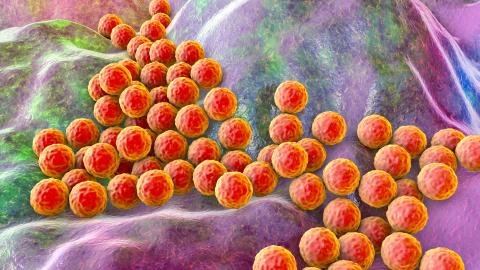Vancomycin-Intermediate/Resistant Staphylococcus aureus (VISA/VRSA)
Staphylococcus aureus, or staph, is a bacterium found in the nose or on the skin of about 30% of people in the United States. Staph bacteria are usually harmless, but they can sometimes cause serious infections. Most staph infections can be treated with antibiotics, but there are some strains that have developed antibiotic resistance.
Vancomycin-intermediate Staphylococcus aureus (VISA) and Vancomycin-resistant Staphylococcus aureus (VRSA) are staphylococcal bacteria that are less susceptible (VISA) or fully resistant (VRSA) to the antibiotic vancomycin. However, VISA and VRSA are usually susceptible to other antibiotics, and infections caused by these organisms are treatable.
VISA/VRSA is spread through close physical contact or through contaminated materials like bandages. Transmission in the community is rare and healthy individuals are at low risk of acquiring VISA/VRSA infections. VISA/VRSA is usually acquired in health care settings. Those at higher risk of VISA/VRSA infections include:
- People who are on prolonged treatment with vancomycin.
- People who require medical devices, like catheters.
- People who have underlying medical conditions.
- People who have had a previous Methicillin-resistant Staphylococcus aureus (MRSA) infection.
Steps health care facilities can take to prevent VISA/VRSA from spreading
- Practice proper hand hygiene before and after contact with patients or their environment.
- Implement contact precautions. This includes wearing a gown and gloves.
The signs of VISA/VRSA infections can look similar to other types of staph infections, causing skin conditions that look like pimples or boils. The skin can also be red, swollen, or warm to the touch.
Sometimes staph bacteria can get into the bloodstream and cause more serious infections such as sepsis, pneumonia, endocarditis (infection of the heart valves), or osteomyelitis (bone infection).
VISA and VRSA are usually susceptible to other antibiotics and infections caused by these organisms are typically treatable.
No known cases of VRSA infections have been reported in Wisconsin. Approximately 50 cases of VISA infections have been reported since they become a reportable communicable disease in 2007.
In 2022, there were two cases of VISA reported in Wisconsin, and in 2023 there were four cases reported. Find more information and data on the multidrug-resistant organisms webpage.
Resources
Antibiotic-resistant germs in hospitals: CDC (Centers for Disease Control and Prevention) webpage with information on antibiotic-resistant germs, including what health care providers are doing to prevent them.
VISA and VRSA are listed as category II reportable communicable diseases. Report to the patient's local public health department electronically, through the Wisconsin Electronic Disease Surveillance System (WEDSS), by mail or fax using an Acute and Communicable Disease Case Report, F-44151 (Word), or by other means within 72 hours upon recognition of a case.
Case Reporting and Investigation Protocol (EpiNet): P-01862 VISA-VRSA (PDF)
More information about communicable disease reporting can be found on the Department of Health Services disease reporting webpage.
CDC resources
- VISA/VRSA in healthcare settings: Webpage with general information and frequently asked questions
- Multidrug-resistant organisms management and guidelines: Recommendations for managing multidrug-resistant organisms in health care settings
- Investigation and Control of Vancomycin-Resistant Staphylococcus aureus (PDF): A guide for conducting public health investigations
Questions about VISA/VRSA? Contact us.
Phone: 608-267-7711 | Fax: 608-266-0049


